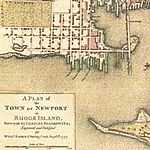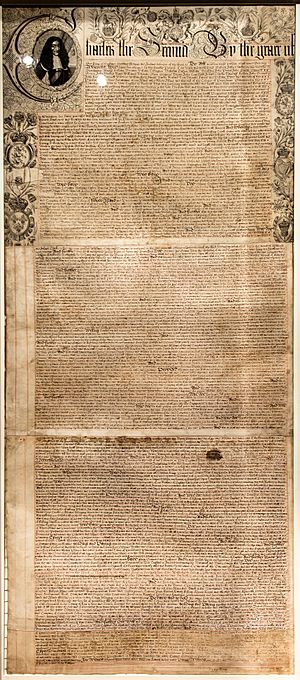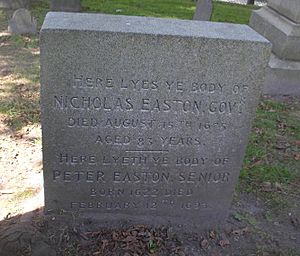Nicholas Easton facts for kids
Quick facts for kids
Nicholas Easton
|
|
|---|---|
| 4th and 8th President of the Colony of Rhode Island and Providence Plantations | |
| In office 1650–1651 |
|
| Preceded by | John Smith |
| Succeeded by | Samuel Gorton (as President of Providence and Warwick) |
| In office 1654–1654 |
|
| Preceded by | Gregory Dexter (as President of Providence and Warwick) and John Sanford as governor of Newport and Portsmouth |
| Succeeded by | Roger Williams |
| 4th Governor of the Colony of Rhode Island and Providence Plantations | |
| In office 1672–1674 |
|
| Preceded by | Benedict Arnold |
| Succeeded by | William Coddington |
| 2nd and 4th Deputy Governor of the Colony of Rhode Island and Providence Plantations | |
| In office 1666–1669 |
|
| Governor | William Brenton |
| Preceded by | William Brenton |
| Succeeded by | John Clarke |
| In office 1670–1671 |
|
| Governor | Benedict Arnold |
| Preceded by | John Clarke |
| Succeeded by | John Clarke |
| Personal details | |
| Born | c.1593 Hampshire, England |
| Died | 15 August 1675 Newport, Rhode Island |
| Resting place | Coddington Cemetery, Newport |
| Spouses | (1) Mary Kent (2) Christian (_______)(Cooper) Beecher (3) Ann Clayton |
| Children | Peter, John, James, Elizabeth |
| Occupation | Tanner, assistant, president, commissioner, governor |
Nicholas Easton (born around 1593, died 1675) was an important early leader in the Rhode Island Colony. He served as both a President and a Governor.
Easton was born in Hampshire, England. He moved to New England in 1634 with his two sons. In the Massachusetts Bay Colony, he supported religious leaders like Anne Hutchinson. Because of his beliefs, he was disarmed and then banished from Massachusetts in 1638.
After leaving Massachusetts, Easton helped found Portsmouth on Aquidneck Island. A year later, he and eight others started a new town called Newport. In Newport, he became very active in government. He was elected President of the four towns of the colony in 1650 and again in 1654.
Later in his life, Easton continued to serve the colony. He was a Deputy Governor and then Governor from 1672 to 1674. The colony became much stronger during this time, thanks to the Royal Charter of 1663. Nicholas Easton was a tanner (someone who prepares animal hides) and also a religious speaker. He became a Quaker. He is buried in the Coddington Cemetery in Newport. Easton's Beach and Easton's Point in Newport are named after him. His son, John Easton, also became a Governor of the colony.
Contents
Early Life in England
Nicholas Easton was born in Lymington, Hampshire, England, around 1593. His father died when Nicholas was young. His mother remarried twice.
While his father and first stepfather worked with salt, Nicholas chose a different path. He became a tanner, working with animal hides. He married Mary Kent, and they had four children. Sadly, his first wife died in 1630. In March 1634, Easton and his two surviving sons sailed to New England on the ship Mary & John.
Moving to Massachusetts
Easton first lived in Ipswich, New England. He was appointed to oversee gunpowder and shot there. He soon moved to Newbury in 1635, helping to found the town.
During a big religious disagreement called the Antinomian Controversy (1636-1638), Easton supported ministers like John Wheelwright and Anne Hutchinson. Because of his views, he and many others were ordered to give up their weapons in 1637.
He then went to Hampton, where he built the town's first house. However, Massachusetts authorities continued to pursue those who disagreed with them. In March 1638, Easton was told to leave the Massachusetts Bay Colony. He soon joined other supporters of Hutchinson in Portsmouth on Aquidneck Island. This island later became part of the Rhode Island colony. In May 1638, he received land in Portsmouth.
Settling in Rhode Island
Nicholas Easton was also a religious speaker. His ideas sometimes caused disagreements with leaders from Massachusetts, like John Winthrop. Winthrop wrote about Easton's religious views, which were different from the strict Puritan beliefs of Massachusetts.
About a year after arriving in Portsmouth, some leaders decided to start a new settlement. On April 28, 1639, Easton was one of nine men who signed an agreement to create a new town. These families moved to the south end of Aquidneck Island and founded Newport. William Coddington, who had been the leader in Portsmouth, led this new settlement. In November 1639, Easton and John Clarke were chosen to seek a land patent for the island from the king.
John Winthrop continued to write about the events in Rhode Island. He often criticized the leaders who had been banished from Massachusetts. In August 1641, he again mentioned Easton's religious ideas. Winthrop noted that Easton, William Coddington, and John Coggeshall had similar views. However, their minister, John Clarke, and others disagreed, causing some tension in the community.
Leading the Colony as President
Once settled in Newport, Easton became very active in government. From 1640 to 1644, he served as an assistant to Governor Coddington. In May 1650, he was elected President of the united colony. This colony included the four towns of Newport, Portsmouth, Providence, and Warwick. He served for one year.
During his first term, the colony's government became the General Assembly. Members received a fixed salary. Military supplies like gunpowder and muskets were given to each town. This showed how strong and populated each town was. Newport received the most supplies, followed by Portsmouth, then Providence and Warwick.
A big problem during Easton's first term was land disputes. Some settlers in Pawtuxet and Warwick had put themselves under the control of the Massachusetts Bay Colony. This caused arguments over taxes and land claims. Roger Williams was asked to go to England to help solve these issues.
To make things more complicated, William Coddington was also in England. He returned with permission to separate the island towns of Newport and Portsmouth from Providence and Warwick. This created two separate governments within the colony.
Another event showed how weak the Rhode Island colony was. Reverend John Clarke, Obadiah Holmes, and John Crandall visited a sick church member in Massachusetts. They were arrested, tried, and found guilty of being Anabaptists. They were fined, and if they didn't pay, they would be whipped. Clarke's fine was paid by a friend. Crandall went home on bail. Holmes was whipped very severely for his beliefs.
From 1651 to 1654, Coddington governed the island towns. Meanwhile, Providence and Warwick had different leaders. Roger Williams returned from England hoping to reunite the towns. He brought a letter from Sir Harry Vane, a friend of the Rhode Island colonists. Vane urged the people to settle their disagreements. This led to Easton's second term as president, from 1654 to 1655. The four towns of the Rhode Island Colony finally reunited under his leadership.
Serving as Colonial Governor
Nicholas Easton was listed as a freeman (a citizen with full rights) in Newport in 1655. He was a commissioner in 1660. For the last ten years of his life, starting in 1665, he became deeply involved in the colony's leadership.
Big changes had happened in England. The government changed from a Protectorate back to a Kingdom. Charles II was on the throne. For Rhode Island, a very positive change came with the Royal Charter of 1663. This important document officially recognized the colony and settled land claims. Easton was one of the important citizens named in this charter.
Easton served as a Deputy in the General Assembly for Newport from 1665 to 1666. Then he became the Deputy Governor of the entire colony from 1666 to 1672. In May 1672, William Brenton was elected Governor but refused the job. So, Easton was elected and served for two terms until 1674. William Coddington then took over as Governor.
Nicholas Easton died in August 1675 at 81 years old. He was buried in the Coddington Cemetery in Newport next to his second wife, Christian.
Family and Lasting Legacy
Nicholas Easton's first wife, Mary Kent, was the mother of all his children. She was the daughter of Thomas Kent and Ellen Pile.
Easton had two sons who grew up and came with him to New England. His older son, Peter, was named after his mother's stepfather. Peter was also active in colonial affairs, serving as a commissioner, assistant, and Attorney General. Peter's daughter, Mary, married Weston Clarke, the son of Governor Jeremy Clarke. His daughter Waite married John Carr, the son of Governor Caleb Carr.
Easton's other son, John Easton, was involved in colonial politics for most of his adult life. He served as governor himself for five terms between 1690 and 1695. Nicholas Easton's widow, Ann, later married Henry Bull, who also served as governor of the colony for two short periods in the 1690s.
Easton's Point in Newport is named after Nicholas Easton, as is Easton's Beach. Historian Thomas W. Bicknell described Easton's Beach as "a permanent monument in the honor of this earnest, faithful, honored founder of Rhode Island..."




